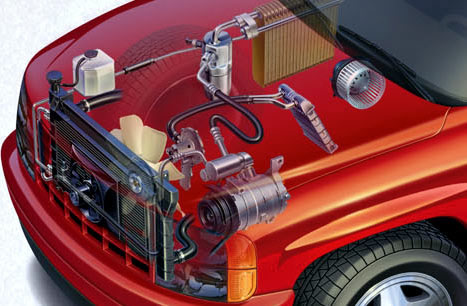Summer’s imminent arrival means your vehicle’s air conditioning system is going to be under a serious strain before long. If you haven’t had your system serviced in a while, now’s the time. While most newer vehicles may simply be able to get away with having their A/C recharged, older cars and trucks may require a little extra attention.
If you think your A/C isn’t as frosty as it used to be, but it’s still blowing cold, the system may need to be recharged. While manufacturers used to use a type of refrigerant known as R-12, or Freon, researchers have found it is a leading cause of ozone depletion. As such, it’s illegal to use Freon in vehicles built after 1994. Now, manufacturers use R-134a to keep things cold in the cabin.
While you can technically recharge your vehicle’s refrigerant yourself, its best left to a qualified professional if you’re not confident in vehicle maintenance. All refrigerants have a tendency to displace oxygen, which means if you accidentally evacuate the system, the stuff could literally push the air out of your lungs. Not fun.
First Steps
Once you take your car in, technicians will measure the amount of pressure in your system, and if it’s low, they’ll add enough to get the reading within your manufacturer’s specifications. They will then run your car for a few minutes with the A/C on high and use a special thermometer to measure the system’s output. If it’s not within the necessary parameters, you may have a leak somewhere in your system.
Fixing a leak is trickier than you may think. Your technician will hook your vehicle up to a special refrigerant recovery system and drain any of the harmful gas from your car. At this point, the technician will inspect all of your air conditioning hard lines to make sure there are no obvious cracks. They may add a tracer dye to the system to help out. The bad news is that leaks are sometimes hard to find, and tracer dye isn’t necessarily a cure-all. The good news is, your expensive hard lines are usually made of aluminum and rarely fail. Instead, it’s likely one of your system’s components is the culprit. First up is your compressor.
The Components
An air conditioning compressor is usually driven by your vehicle’s serpentine belt, and as it spins, it pressurizes the system’s refrigerant. Simply put, it’s this change in pressure that cools the air coming into your cabin. An A/C compressor spins at a dizzying rate, and the more you use the cool side of your thermostat, the more likely it is to eventually fail or leak. One of the main differences between R-12 and R-134a is that the new refrigerant requires supplementary oil to be added to the system to make everything function. R-12 did not. If your compressor has run low on oil, it’s possible the interior seals have failed and you’ll need a new unit. Unfortunately, compressors aren’t cheap.
The best way to keep your compressor from failing is to have your A/C system serviced once a year, including the addition of the right kind of lubrication for your unit. If it does come down to replacing your compressor, most responsible shops will recommend going ahead and swapping out a number of periphery components at the same time. Why? The easy answer is working on an air conditioning system is about as much fun as sticking your hand in a blender. Twice. So to avoid draining your refrigerant, removing your compressor, installing a new unit and refilling the system with new cool stuff, only to have you come back in a week and say it’s still not cold enough, it makes sense to replace the necessary components. It keeps you from having to waste time and money, and it makes sure they get the problem solved the first time.

What’s Involved In Servicing Your Car’s Air Conditioning
by
Tags:

Leave a Reply